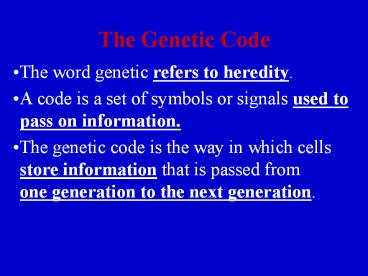The Genetic Code - PowerPoint PPT Presentation
Title:
The Genetic Code
Description:
The Genetic Code The word genetic refers to heredity. A code is a set of symbols or signals used to pass on information. The genetic code is the way in which cells ... – PowerPoint PPT presentation
Number of Views:220
Avg rating:3.0/5.0
Title: The Genetic Code
1
The Genetic Code
- The word genetic refers to heredity.
- A code is a set of symbols or signals used to
pass on information. - The genetic code is the way in which cells
store information that is passed from one
generation to the next generation.
2
The Search for the Genetic Code
- Frederick Griffith He studied bacteria that
caused pneumonia in mice. - In 1928 he did the following experiment.
3
Transformation Of BacteriaTwo Strains Of
Streptococcus
Rough Strain (Harmless)
Smooth Strain (Virulent)
4
Transformation Of BacteriaThe Griffith Experiment
OUCH!
5
The Search for the Genetic Code
6
The Search for the Genetic Code
- Results from 4 show that the heat-killed strain
had passed to the live harmless strain its
disease-causing ability. - That is, one form of bacteria was transformed
into another form. - Griffith called this process transformation.
- He hypothesized that a factor was transferred
from the heat killed cells into the live cells
7
The Search for the Genetic Code
- Oswald Avery and others In 1944 they repeated
Griffiths experiment to see which molecules
were responsible for the transformation. - From the heat-killed bacteria they made an
extract or juice. - Individually they treated the extract with
enzymes that destroy lipids, proteins,
carbohydrates, and RNA.
8
The Search for the Genetic Code
- The results were that transformation still
occurred and so none of these molecules were
the transferring agent. - They repeated the experiment with enzymes that
break down DNA (deoxyribonucleic acid). - The results were that transformation did not
take place.
9
Yes
Lippase
Yes
Protease
Yes
Saccharase
No
Nuclease
10
The Search for the Genetic Code
- Conclusion DNA is the transforming material and
is the molecule that stores and transmits the
genetic code from one generation of an organism
to the next.
11
SEARCH FOR THE GENETIC CODE CONTINUES
- After the Oswald Avery experiment some scientists
still remained skeptical that DNA was the
genetic material. - In 1952 the following experiment was done by
Alfred Hershey and Martha Chase.
12
The Hershey-Chase Experiment
- They used bacteriophages which are viruses that
infect bacteria (e.g., T2 phage). - They are composed of a DNA core and a protein
coat. - They infect bacteria by attaching to the
surface and injecting material.
13
The Hershey-Chase Experiment
- The injected material is used to make many
copies of the virus. - Viral copies are produced until they cause the
bacteria to burst, releasing the virus. - Because the injected material is used to make
copies, it must be the genetic code. - Important question What is being injected from
the virus, the protein coat or DNA core?
14
The Hershey-Chase Experiment
- They labeled the protein coat of the virus with
radioactive sulfur-35. - They labeled the DNA core of the virus with
radioactive phosphorus-32. - They mixed the labeled viruses with the
bacteria, waited for injection, then
separated the parts using a blender and
centrifuge.
15
The Hershey-Chase Experiment
- Hershey and Chase took advantage of the fact that
T2 phage is made of only two things Protein and
DNA
16
Using S35
When centrifuged, phage protein coats remain in
the supernatant while bacteria form a pellet
The supernatant is radioactive, but the pellet is
not.
Did protein enter the bacteria?
Is protein the genetic material?
17
Using P32
When centrifuged, phage protein coats remain in
the supernatant while bacteria form a pellet
The pellet is radioactive, but the supernatant is
not.
Did DNA enter the bacteria?
Is DNA the genetic material?
18
The Hershey-Chase Experiment
19
The Hershey-Chase Experiment
- Conclusion
- The Hershey-Chase experiment showed definitively
that DNA is the molecule that carries the genetic
code.
20
AN IMPORTANT QUESTION REMAINED WHAT IS THE
STRUCTURE OF DNA?
- In the early 1950s Rosalind Franklin Maurice
Wilkins took x-ray pictures of the DNA molecule. - These x-ray pictures provided important clues
about the structure of DNA. - For example, the fibers that make up DNA are
twisted and the molecules in the fibers are
spaced out in regular intervals.
21
AN IMPORTANT QUESTION REMAINED WHAT IS THE
STRUCTURE OF DNA?
- Another important piece of information on the
structure of DNA was provided by Erwin
Chargaff. - He observed that in any sample of DNA, the
number of - Adenine molecules (A) (T) Thymine molecules
- Cytosine molecules (C) (G) Guanine molecules































